- Chemical filling
- Collection of raw materials
- 7 facets of medicinal plant
- Culinary "exploitation"
- Medical purpose
- Application of sage in cosmetology
- Contraindications
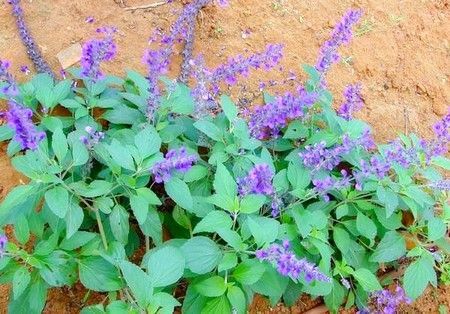 Salvia is a unique plant that is treated by diseases in all countries of the world. The path of the natural healer began with the words of Hippocrates, who called it the source of health, beauty and vitality. Among all the varieties of medicinal herbs( and there are about 900 of them), the most useful are the Ethiopian, Spanish, Muscat, meadow varieties.
Salvia is a unique plant that is treated by diseases in all countries of the world. The path of the natural healer began with the words of Hippocrates, who called it the source of health, beauty and vitality. Among all the varieties of medicinal herbs( and there are about 900 of them), the most useful are the Ethiopian, Spanish, Muscat, meadow varieties.
Infusion and decoction of sage contain a great healing power, capable of curing even infertility, not to mention colds, digestive disorders and various inflammations.
Chemical filling
The sage composition includes a huge number of useful substances: flavonoids, mineral salts, phytoncides, essential oils, organic acids, vitamins A, B, PP, choline, phosphorus, magnesium, calcium, potassium, copper, iron anda rare vitamin K. The interaction of all these trace elements and provides the plant with the glory of an all-powerful healer.
Collection of raw materials
Sage in the wild on the lands of Russia is not found. It is usually cultivated in the Crimea, the Caucasus and the southern regions of the country. For medical purposes, use leaves of the plant, which have a strong aroma and a bitter taste with the presence of spicy notes. The broth of a sage possesses strong astringent and anti-inflammatory action, and is applied both internally, and externally. The plant is often used in cooking, adding in the form of spices to meat, snacks and pastries.
The collection of medicinal raw materials usually occurs during the formation of buds. Collect at the top of the stems and leaves, which are then dried in a draft and away from sunlight.
Attention! Collection of sage can be performed 2-3 times per summer, so its leaves and stalks periodically grow.
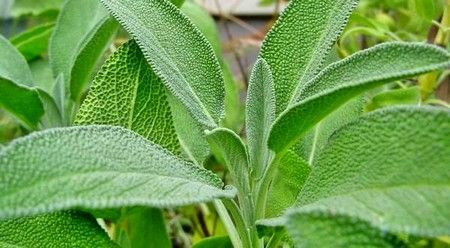
7 facets of medicinal plant
Sage broth, the use of which is not limited to medicine alone, has a multifaceted therapeutic effect:
- has antiseptic, anti-inflammatory, hemostatic, bactericidal and healing effect;
- has urine and diaphoretic properties;
- is accepted for general health purposes;
- increases immunity;
- improves the activity of the gastrointestinal tract;
- expels the common cold and flu;
- treats infertility, atherosclerosis and hemorrhoids.
Attention! With regular intake of sage broth inside, excess kilograms go away.
Culinary "exploitation"
Sage is a favorite spice of cooks and gourmands, which apply it both fresh and dried. Freshly picked leaves of the plant improve the taste of dishes made of meat, fish and vegetables, and dried - serve as a condiment for sauces, soups, broths. In addition to all the sage - a great base for alcoholic and non-alcoholic beverages.
Medical prescription
Salvia officinalis is an ardent fighter with many diseases ranging from mild colds and ending with infertility. Consider several medicinal recipes based on it.
With Infertility
Even in Ancient Egypt, women actively drank a sage broth to become pregnant. In those days, it was generously seasoned with salt, but modern medicine does not accept the ancient recipe.
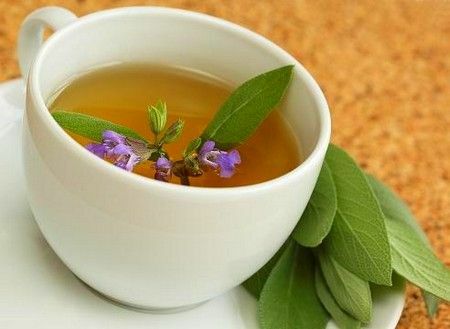
The modern infertility remedy is prepared as follows: dried leaves of the plant( 1 tablespoon) are poured with boiling water( 200-300 ml), cooked over moderate heat for 10 minutes and insisted for half an hour. Ready-mixed broth is filtered and taken 3 times a day for 1 tablespoon.
Attention! The recipe besides the healing of infertility improves memory and stops lactation.
With Atherosclerosis
Sage herb has a beneficial effect on the nervous system, relieving stress, stress and healing atherosclerosis. People suffering from this disease, and elderly patients are advised to drink the tincture of the plant for alcohol.
For its preparation, dry, shredded sage leaves( 3 tablespoons) are poured with vodka or alcohol( 0.5 liters) and insist 30 days in a sunny place in a sealed container of dark glass. Ready tincture is drunk on 1 tablespoon once a day and always on an empty stomach. Keep the liquid in the refrigerator.
With inflammations of
Sage broth perfectly removes both internal and external inflammation. To make a medicinal preparation dried leaves( 2 teaspoons) pour boiling water( 1-2 glasses) and leave to infuse for 1-2 hours. The finished filtered broth is used for many purposes:
- as lotions and compresses for bruises, bruises, sprains and bruises;
- for washing wounds, cuts and burns;
- for the treatment of dermatitis and herpes;
- for rinses with periodontal disease, caries, gingivitis, stomatitis, angina, ulcers in the corners of the mouth and other inflammations of the oral cavity( 3-4 times a day);
- for syringing with infectious ailments of urogenital organs, with vaginitis and vulvitis;
- with inflammation of the gastrointestinal tract, liver and gallbladder( in this case, the sage broth is taken orally 1 tablespoon every 2-3 hours).
As sedative
Sage has a powerful soothing effect, it helps with insomnia, nervous breakdowns and increased excitability. This is an excellent cure for stress, neuralgia, depression and mood swings( especially during menopause).
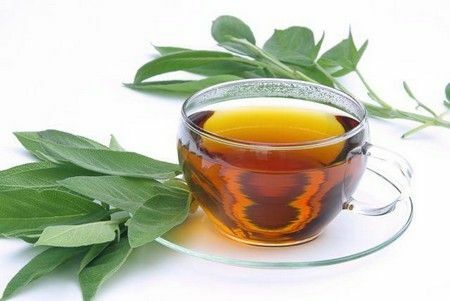
For this, pour dry leaves( 1 teaspoon) with steep boiling water( a glass) and drink at night looking.
In respiratory diseases
Cure pneumonia, bronchitis and other ailments of the upper respiratory tract will help the application of sage broth on milk. To prepare a healing drink, leave the leaves of the plant( 1 teaspoon) with hot milk( 1 glass), boil on low heat for 7-8 minutes and insist for a quarter of an hour. Then filter the broth, squeeze and boil again. Drink hot for the night. The product has excellent expectorant properties and effectively removes mucus from the lungs.
For digestive disorders
Weak sage infusion( 1 teaspoon of raw materials per 0.5 liters of boiling water), taken 3-4 times a day for 1 tablespoon before meals, improves digestion, eliminates constipation, colic in the abdomen and swelling. Duration of admission for these problems - 10 days.With hemorrhoids
3 tablespoons of dry raw materials pour 100-150 ml of boiling water and dilute the broth to the desired volume with boiled water. Obtain a daily fluid enema. A week later, the disease will be eliminated.
With a cold and the flu
Many people are wondering whether it is possible to drink a sage broth in ARI and colds? Folk doctors respond positively. In this case, tea is made from linden and sage( 1 tablespoon of dried raw material per 1 liter of boiling water).The duet of two medicinal plants, rich in resins and essential oils, acts as an effective preventive and curative remedy for colds, influenza and strengthening immunity.
Application of sage in cosmetology
For face
In cosmetology, a sage broth for the face( 1 tablespoon per cup of boiling water) solves many problems:
- Eliminates acne, pimples, rashes and various rashes on the skin. This is promoted by the antibacterial qualities of sage. It removes inflammation, soothes the skin, cleanses the pores, normalizes the work of the sebaceous glands.
- By means of compresses it removes dark circles under the eyes, refreshes and tones the skin.
- Moisturizes dry skin and normalizes metabolic processes.
- Thanks to the presence of phytohormones, sage infusions can have a rejuvenating effect. After a number of procedures the skin becomes elastic, silky and smooth, fine wrinkles are smoothed out. The plant restores the hormonal balance and promotes complete regeneration of the skin.

Attention! Decoction of sage can be used for lotions and washings, or you can freeze in an ice mold. The received cubes should be wiped face once a day.
For hair
Sage broth is also actively used for hair. Rinsing their head after washing, you get rid of dandruff, stop the processes of loss and activate the growth of hair bulbs. Your locks will acquire a glossy glow, silky and healthy elasticity.
Masks and balms on the basis of this plant eliminate oily shine, control the work of the sebaceous glands and treat seborrhea, dermatitis.
Contraindications
Attention! An overdose of the drug can cause severe headaches and poisoning of the body.
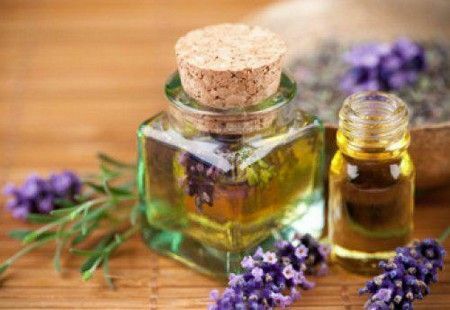
Like all medicinal plants, sage has contraindications. Its administration( inside and outside) is prohibited:
- during pregnancy and lactation;
- for malfunctions in the pancreas;
- for hypertension:
- for uterine diseases: myoma and endometriosis;
- for polycystic ovaries;
- for allergies.
Warning! In the case of daily reception of sage broth, every 3 months, interrupt the course for 20-30 days. This is necessary to ensure that the body is cleansed of tannins and resins contained in the plant.
Is it possible to drink sage broth without prescribing a doctor? It is possible, but undesirable. In view of the presence of contraindications, you should still consult with specialists.
